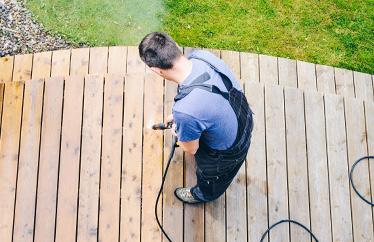Spring Home Maintenance Checklist To Prep for 2024 Spring Weather

Spring is in the air, and it’s time to trade chilly evenings for longer and warmer days. It’s also time to check how your home endured the winter and what needs to get done to prepare for spring weather. This includes cleaning up winter debris on the roof and lawn, checking for damage or mold along your home’s exterior, and completing maintenance that helps protect your home from spring storms and temperature changes.
In our annual Housepower Report, we learned that nearly a third of responding homeowners experienced severe weather, and more than a quarter experienced drastic temperature changes. In 2023, spring and summer seasons were reported by the National Oceanic and Atmospheric Administration (NOAA) as high-risk periods for concurrent climate events and severe weather (like severe storms and river flooding) (NOAA, January 2024).
If your home has underlying damage from the winter, you may be at risk of major damage if a bad storm rolls through. To help you prepare, we put together a spring home maintenance checklist of the most important tasks that can help prevent serious problems.
Download our spring home maintenance checklist to prepare for spring weather
Getting your home ready for the spring season requires a handful of to-dos. Download our spring home maintenance checklist to help you keep track of the most important tasks.


1. Inspect and repair roof, gutters, and attic
Why? These areas of your home may have experienced wear and tear in the winter months from storms, snow, wind, and accompanying debris. Although your roof system may have withstood the winter, it may need repairs or replacements. Following these spring home maintenance tips to catch issues now can help keep your home structurally sound and comfortable during spring storms and throughout the rest of the year.
Effort required: Low to medium
Steps to take:
-
Visually inspect your roof from the ground for any signs to fix your roof. Check for missing or damaged shingles, leaks or water stains, sagging, and dark streaks (a sign of possible moss or algae growth). Contact a roofing professional for a thorough inspection and help addressing extensive repairs.
-
Look around your attic for water stains, mold, pests, and other signs of moisture or ventilation issues. Poor ventilation can lead to a deteriorating roof system and poor insulation for the rest of your home. Solutions may require installing new insulation, vents, and attic fans, as well as replacing damaged parts.
-
Check your gutters, downspouts, and nearby storm drains for blockages and signs of damage to help prevent pooling water and related structural damage. Downspouts should also help direct stormwater away from the home toward storm drains. Clear debris, replace broken parts, and, if your city maintains nearby storm drains, contact your city’s appropriate office to address storm drain maintenance or drainage issues.
2. Do a walk around your home’s exterior
Why? Like your roof system, the exterior of your home needs a thorough check to address weakened areas, replace extensively damaged parts, and catch issues like pest infestations before they can potentially lead to more expensive repairs and projects.
Our recent 2024 Financial Goals Report revealed that exterior and structural maintenance was the top-ranked savings priority for responding homeowners. Investing in proactive professional evaluations and minor repairs now can help you avoid future costly and disruptive construction that may be needed for major foundation repairs.
Effort required: Low to medium
Steps to take:
-
Check parts of your home made of wood for signs of water damage, like warped boards or rot. You may need to repair or replace damaged parts and clean and reseal the remaining parts to help prevent further issues. Call a professional for an evaluation and help with repairs.
-
Look around your home for signs of damage like cracks, water stains, or peeling paint on your exterior walls. Look for signs of pests, such as crumbling wood, mud tubes that termites can form around your home’s foundation, and visible droppings. Prioritize repairing damaged areas and sealing openings to avoid inviting pests and the elements into your home.
-
Inspect your deck and driveway for damage that seasonal storms can potentially exacerbate. Sweep decks, including the cracks in between boards, to help prevent rot and drainage issues. Immediately address hairline cracks in driveways to help prevent water penetration from above when it rains and investigate larger cracks, which may indicate structural issues.
3. Tend to your landscaping and outdoor fixtures
Why? Inspecting your plants and outdoor fixtures can help you spot issues caused by winter weather and prepare them for the next season. In addition to helping promote new growth, maintaining your yard and landscaping are spring home maintenance tasks that can also help get you ahead of potential storm damage. For example, improving your yard’s drainage can help prevent pooling water and excess runoff on your lawn. Proper drainage can help protect your lawn’s roots from disease.
Effort required: Low to medium
Steps to take:
-
Rake your lawn and remove dead leaves, weeds, branches, and other debris that could impede your lawn’s growth. A clean and healthy lawn can also help prevent damage from critters.
-
Inspect irrigation systems, including sprinkler heads, pipes, and spigots, for signs of damage from the winter weather or snow removal equipment. Check your water schedule and test your system to ensure everything still works and that water isn’t hitting your home or the sidewalk.
-
Trim broken and dead tree branches to help stimulate new growth. Prune limbs that are close to your home to help prevent water runoff or damage during spring storms. Contact a certified arborist if you have a leaning tree, extensive decay, or notice other concerning damage that may lead to your tree falling over.

4. Assess and clean windows and doors
Why? Windows and doors can become entry points for rain, wind, and debris without proper maintenance. Snow and rain from the winter may have also taken their toll on weatherstripping, caulking, screens, and other parts of your windows and doors.
Effort required: Low to medium
Steps to take:
-
Inspect seals and caulking around doors for missing chunks, mold, peeling, and other signs that they need to be repaired and replaced. Clean window sills and areas around external doors to help prevent mold and mildew growth and pooling water.
-
Inspect window and door screens for tears, rust, debris, and mold. You can use a screen repair kit to address small tears or holes and clean off mold and debris yourself. However, Home Depot recommends replacing the entire screen for major issues like large tears or extensive rust on metal frames. Well-maintained screens can help prevent water from pooling near your window during storms and keep hail from hitting windows and doors directly.
-
Consider installing storm doors if your external doors have noticeable damage from severe weather. Storm doors can also help improve insulation, and their screens can help ventilate your home on warmer days.
5. Service your critical systems
Why? Severe weather can strain your critical systems, especially if they aren’t being regularly serviced or maintained. Our 2023 Housepower Report revealed that nearly a quarter of responding homeowners experienced their HVAC system breaking down in the past 12 months. A breakdown can cause major stress and headaches, leaving your household susceptible to sudden temperature changes and unexpected repair costs.
If a critical system like your HVAC system is already struggling, severe storms can exacerbate the issue and may lead to prematurely needing a replacement. According to Home Dept, an HVAC tune-up can cost about $99 and up, while a new HVAC system can cost between $5,000 and $12,000.
Effort required: Medium
Steps to take:
-
Replace HVAC filters and clean air ducts and vents to help prevent the buildup of allergens, dust, or mold that may have accumulated during the winter. Clear debris around outside units and vacuum and dust interior units to help your HVAC work efficiently, last longer, and help keep your home comfortable.
-
Check and test all of your pipes, connections, hoses, and areas around plumbing fixtures for signs of leaks, loose connections, or damaged seals and grout. Address pipe and sewage line clogs right away to help prevent backups during storms. Heavy rain can exacerbate existing plumbing issues, leading to blockages, leaks, or burst pipes.
-
Test smoke and carbon monoxide detectors and replace old batteries. Check and test all fire extinguishers to see if they’re still working and whether it’s time to replace or recharge (refill) them. Although you may not associate spring with fires, spring weather hazards like lightning and thunderstorms can indirectly lead to fires by causing power surges and physically downing structures like power lines.
6. Look for potential issues in the basement
Why? The state of your basement can clue you into other potential issues with your foundation or plumbing system in your home.
Your basement may experience leaks toward the end of winter and the beginning of spring because of changing temperatures. For example, melting snow combined with poor drainage can lead to pooling water near your home’s foundation. Water can seep through existing cracks in your basement, expanding them and allowing even more water through. Identifying potential problems in your basement can help prevent major issues that can happen as a result of flooding or heavy rain.
Effort required: Medium to high
Steps to take:
-
Look for signs of water damage in the walls, floor, and belongings stored in your basement. This includes visible signs of moisture or standing water (especially where the wall and floor meet), mold or mildew, cracks, and musty smells. Plan to address visible cracks and contact a foundation specialist for help with significant cracks or issues.
-
Inspect your sump pump to help ensure it can function during heavy rain and help prevent water damage. Start by disconnecting the pump and cleaning out the sump pump pit, surrounding area, and components of the sump pump itself to avoid clogs. Then, connect and test it by filling the pit with water. If it doesn’t turn on and drain the water, check connections, signs of lingering debris, and if parts need replacement.
-
Check window wells, vents, exhaust fans, dehumidifiers, and anything else in your basement used to improve ventilation and manage humidity. Clean window wells, filters, and surrounding debris and dust to ensure each system functions. Maintaining ventilation can help prevent mold since a basement’s location can make it more prone to humidity.
7. Clean and upkeep your home’s interior
Why? Spring cleaning has more benefits than you may think. In addition to refreshing your space for the new season, tidying up can help make your home safer in emergencies, help you catch issues early, and improve your home’s health.
For example, deep cleaning can help you spot signs of mold or water damage that you may not have noticed otherwise. This can include commonly overlooked areas like vents and upholstery.
Effort required: Medium to high
Steps to take:
-
Deep clean your home from top to bottom to sweep out irritants and allergens that may have settled in during the winter and to spot early signs of potential problems. This includes checking and cleaning hard-to-reach or time-consuming areas like ceiling fans, exhaust fans, and soft surfaces (like cushioned furniture).
-
Remove unnecessary clutter around your home and clear pathways to all exits. Collections of old newspapers, cardboard boxes, and even cluttered kitchen counters can cause a fire risk.
-
Shampoo carpets and clean hard surfaces to remove any existing buildup of dirt and spills that could lead to long-term damage. Once your hard surfaces are clean, use floor sealants to help prevent moisture from penetrating your floor and increase its longevity. For extra protection, add a sturdy welcome mat at your front door and heavy rugs in high-traffic areas to help protect your floor from rainy or muddy shoes.

8. Make additional preparations for extreme spring weather
Why? Small precautions can help make a difference in your home’s health and the safety of your loved ones during an extreme weather event. The U.S. saw 28 billion-dollar weather events (weather and climate events that result in at least $1 billion of damage) in 2023, up from 18 in 2022 (NOAA 2024). Given the increase in severe weather this past year, emergency kit preparations and homeowners insurance policy reviews are crucial additions to your spring home maintenance checklist.
More Americans have also recognized this—48% of those surveyed in 2023 said they assembled or updated supplies compared to only 33% in 2022 (Federal Emergency Management National Household Survey, 2023).
Effort required: Medium to high
Steps to take:
-
Use an emergency preparedness checklist to create or contribute to your emergency kit and replace or add items as needed. Review your emergency plan and update outdated information. Then, go over the plan with everyone in your household.
-
Create or update your home inventory to help you file an accurate claim in the event your home or belongings are damaged. You can take a video, create a spreadsheet, or use a home inventory app. While you’re doing this, you can also store important documents in waterproof containers and move valuables and electronics to higher shelves to help prevent damage during floods.
-
Check your homeowner's insurance policy to learn about what scenarios are covered and if you may need additional coverage based on local hazards. For example, you may need additional water backup coverage if water backs up through sewers or drains.
Preparing your home for seasonal issues can require many types of projects, ranging from fixing leaky faucets to patching up cracks. While some to-dos are easy to spot, it can be easy to miss crucial preventative maintenance tasks.
The free Hippo Home app provides personalized maintenance checklists to help you keep up with everything your home may need. We also have DIY guides to help walk you through different home maintenance tasks.
Download the Hippo Home app today from the Google Play Store or the App Store.
Disclaimers
YourHaus, Inc. ("Hippo Home") is an affiliate of Hippo Insurance Services. Services (including all repair or maintenance services) provided to customers through affiliated and unaffiliated third-party contractors. Your use of Hippo Home is subject to Hippo Home's terms and conditions and privacy policies. Use of unaffiliated third-party vendors is subject to the terms of service provided by such third party. Hippo Insurance Services is not responsible for your use/non-use of Hippo Home or any service vendor. @ YourHaus, Inc. 2023
Hippo Insurance Services ("Hippo") is a general agent for affiliated and non-affiliated insurance companies. Hippo is licensed as a property casualty insurance agency in all states in which products are offered. Availability and qualification for coverage, terms, rates, and discounts may vary by jurisdiction. We do not in any way imply that the materials on the site or products are available in jurisdictions in which we are not licensed to do business or that we are soliciting business in any such jurisdiction. Coverage under your insurance policy is subject to the terms and conditions of that policy. Coverage and coverage amounts selected are the decision of the buyer.
This guidance and advice is not error-proof and not applicable to every home. You are responsible for determining the proper course of action for your property and neither Hippo nor Hippo Home is responsible for any damages that occur as a result of any advice or guidance.




